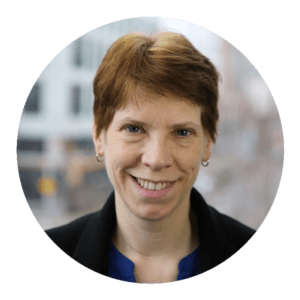
Jennifer Hadlock, MD
The 2023 High School Interns had a great and insightful opportunity to interview Dr. Hadlock, an Assistant Professor and Director of Medical Data Science about her experiences/journey in the STEM field. Dr. Hadlock explained that her path through STEM was not a straight line but instead, it was about discovering that she was passionate about research and development with interdisciplinary teams. Dr. Hadlock originally studied Mathematics and Geographic Information Systems (GIS) as an undergraduate and went on to work at Microsoft for fifteen years. She worked on technologies that are now used worldwide, including natural language processing and digital imaging. While she was passionate about the methods used for developing complex software systems, she wanted to be more actively involved in helping address health issues in the larger community. She went on to earn an MD from the University of Washington School of Medicine and enjoyed learning about human biology, health across the lifespan, and newly emerging approaches to research. After medical school, she joined ISB and established a new lab focused on integrating longitudinal clinical data into systems biology.
What got you interested in Geographic Information Systems (GIS) and how do you apply the information you learned in that major to scientific research?
It’s been relevant in several ways. First, you have to think very deeply about how multidimensional information is captured, stored, transformed, and represented. When you conduct spatiotemporal analysis, there are many ways to make things look interesting, but it’s also possible to draw unfounded conclusions, or perpetuate biased assumptions. That same rigorous scientific thinking applies in biomedical research, particularly when working with secondary data from multiomics studies or electronic health records. Second, our lab applies privacy-preserving methods for analyzing spatial data to investigate patterns between exposures and health outcomes. Third, the body is three dimensional, and we frequently use biomedical knowledge of spatial proximity in our work with immune-mediated inflammatory disease, from gross anatomy down to molecular interactions.
How has your work at developing natural language processing (NLP) technology translated to your medical research at ISB?
We’re currently using NLP and large language models (LLMs) to find information in medical notes that isn’t stored in a structured way. Also, working with continually evolving technologies helped me learn ways to think about when to adopt existing solutions and when to design new ones.
In science, experiments are seen as the gateway to new developments but sometimes these experiments don’t always succeed. How do you maintain motivation in scientific research?
It helps to pursue research where you enjoy daily work – the methods, skills and knowledge required – while working toward having a long term impact in an area you care about. In our lab, we want to improve the lives of patients with immune-mediated inflammatory disease. We design experiments so that, whatever the results, we’re advancing our understanding of medicine, methods, or both. We’re also part of the global community of scientists.
Each experiment may be a small step forward, but collectively we can have a profound impact.
In summary, this conversation helped us better understand what it's like being a scientist in STEM and to let your passion guide your next career steps.
The High School Interns had an amazing conversation with Dr. Hadlock. We talked about a variety of topics such as how interactions between genetics and environmental factors can affect health, and what researchers have learned about COVID-19’s effects during pregnancy. However, most memorable was the conversation we all had with regard to being in STEM. She was curious about how we felt and we also were able to ask her questions about the challenges and rewards of being a scientist. We also asked her what it was like leading her own lab. She discussed how interdisciplinary projects can take time to build initially, given differences in knowledge, skills and professional cultures, but are then very rewarding – teams can make connections that would be difficult to discover from within a single field.